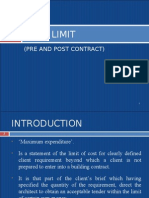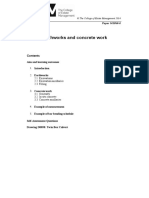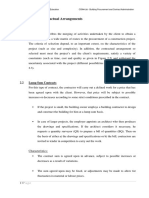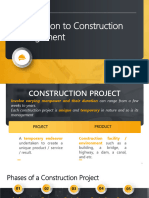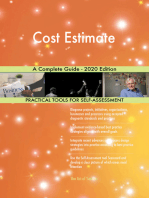To Give A Reasonably Accurate Idea of The Cost
To Give A Reasonably Accurate Idea of The Cost
Uploaded by
michael_angelo_pangilinan9286Copyright:
Available Formats
To Give A Reasonably Accurate Idea of The Cost
To Give A Reasonably Accurate Idea of The Cost
Uploaded by
michael_angelo_pangilinan9286Original Title
Copyright
Available Formats
Share this document
Did you find this document useful?
Is this content inappropriate?
Copyright:
Available Formats
To Give A Reasonably Accurate Idea of The Cost
To Give A Reasonably Accurate Idea of The Cost
Uploaded by
michael_angelo_pangilinan9286Copyright:
Available Formats
Introduction and Orientation to the Course
Purpose of Estimating:
To give a reasonably accurate idea of the cost An estimate is necessary to give the owner a reasonably accurate idea of the cost to help him decide whether the work can be undertaken as proposed or needs to be curtailed or abandoned, depending upon the availability of funds and prospective direct and indirect benefits. For government works proper sanction has to be obtained for allocating the required amount. Works are often let out on a lump sum basis, in which case the Estimator must be in a position to know exactly how much expenditure he is going to incur on them
1. Estimating Materials From the estimate of a work it is possible to determine what materials and in what quantities will be required for the work so that the arrangements to procure them can be made. 2. Estimating Labor The number and kind of workers of different categories who will have to be employed to complete the work in the specified time can be found out from the estimate. 3. Estimating Plant An estimate will help in determining amount and kind of equipment needed to complete the work. 4. Estimating Time The estimate of a work and the past experience enable one to estimate quite closely the length of time required to complete an item of work or the work as a whole. Whereas the importance of knowing the probable cost needs no emphasis, estimating materials, labor, plant and time is immensely useful in planning and execution of any work.
When are estimates reviewed: Prior to bidding During negotiations After contract award
Purpose of Reviewing estimates: 1. 2. 3. 4. 5. To correct possible errors and finalize bid proposal To take consideration revised conditions as well as new information To evaluate position during negotiations To establish budget (for control purposes) To analyze feasibility of alternate schemes construction methods.
Introduction and Orientation to the Course
Suggestions in Checking Estimates: 1. 2. 3. 4. 5. Undertake parallel estimates Compare quantity ratios with similar projects Prioritize high value items Review non-standard details Take note of common mistakes
Sources of Errors in Estimating: 1. 2. 3. 4. 5. 6. 7. 8. 9. Misinterpretation of drawings especially when assumptions are made on specific details Not consulting technical specifications digest Careless use of scale Computation error Factoring error Not updated pricing standards Not realistic factor of safety No inventory of actual drawings received Not familiar with methodology
Types of Construction Estimates: There are several kinds of estimating techniques; these can be grouped into two main categories
1. Approximate Estimates An approximate estimate is an approximate or rough estimate prepared to obtain an approximate cost in a short time. For certain purposes the use of such methods is justified.
2. Detailed Estimate A detailed estimate of the cost of a project is prepared by determining the quantities and costs of everything that a contractor is required to provide and do for the satisfactory completion of the work. It is the best and most reliable form of estimate.
A detailed estimate may be prepared in the following two ways
(a) Unit Quantity Method In the unit quantity method, the work is divided into as many operations or items as are required. A unit of measurement is decided. The total quantity of work under each item is taken out in the proper unit of measurement. The total cost per unit quantity of each item is analyzed and worked out. Then the
Introduction and Orientation to the Course
total cost for the item is found by multiplying the cost per unit quantity by the number of units. For example, while estimating the cost of a building work, the quantity of brickwork in the building would be measured in cubic meters. The total cost (which includes cost of materials. labor, plant, overheads and profit) per cubic meter of brickwork would be found and then this unit cost multiplied by the number of cubic meters of brickwork in the building would give the estimated cost of brickwork. This method has the advantage that the unit costs on various jobs can be readily compared and that the total estimate can easily be corrected for variations in quantities.
(b) Total Quantity Method In the total quantity method, an item of work is divided into the following five subdivisions: Materials Labor Plant Overheads Profit.
The total quantities of each kind or class of material or labor are found and multiplied by their individual unit cost. Similarly, the cost of plant, overhead expenses and profit are determined. The costs of all the five sub-heads are summed up to give the estimated cost of the item of work. For example, the cost of brickwork in a building would be determined as below: ( i ) Cost of Materials at the source $ Bricks $ Sand $ Cement $ Water $ (ii) Cost of Handling and $ transporting above materials Cost of Labor, both skilled and $ unskilled Cost of plant $ Overheads $ Profit $ Total Cost of Brickwork $
II III IV V
Introduction and Orientation to the Course
Importance of Construction Cost estimates: 1. During design and planning stages Preliminary cost advise or budgetary purpose Studying possible design options Cost planning 2. Prior to construction Basis for pricing of tenders 3. During construction Basis for project/cost control Basis for billing and collection Evaluation progress at work Basis for variation claims 4. Post-Construction Performance analysis of the project Estimating Phases in a Project Cycle: 1. 2. 3. 4. 5. 6. Budgetary estimate Programming estimate Schematic estimate Preliminary estimate Final or working documents estimates Construction estimates
Documents comprising the contract: Contract Agreement Conditions of Contract Drawing / plans Relevant specifications Invitation to bid Instruction to bidders Addenda Bid form including 1. Authority of the Signing Official 2. Bid prices in the Bill of Quantities 3. Detailed Estimates
Factors necessary to produce an accurate estimate: 1. Completeness of a. Technical drawings b. Specifications c. Contract documents 2. Site visit a. Familiarity of site condition b. Familiarity of location such as availability of utilities roads materials and labor c. Familiarity of local ordinances, local working habits and attitudes
Introduction and Orientation to the Course
3. Supply of estimate data a. Statistical productivity measures b. Histograms of past projects performances, issues and problems Data Required for Preparing an Estimate: In order to prepare a detailed estimate the estimator must have with him the following data: 1. Plans, sections and other relevant details of the work. 2. Specifications indicating the exact nature and class of materials to be used. 3. The rates at which the different items of work are carried out. To enable an estimator to take out the quantities accurately, the drawings must themselves be clear, true to the fact and scale, complete, and fully dimensioned. The estimator has also to bear in mind certain principles of taking out quantities. Steps in Preparation of an Estimate: There are three clearly defined steps in the preparation of an estimate. 1 . Taking out quantities In the first step of taking out quantities, the measurements are taken off from the drawings and entered on measurement sheet or dimension paper. The measurements to be taken out would depend upon the unit of measurement. For example, in the case of stone masonry in superstructure, length, thickness and height of the walls above plinth level would be taken out from the drawings and entered on the measurement sheet, whereas, in the case of plastering only the lengths and heights of the walls would be entered. Obviously, the unit of measurement in the first case is cubic meter and that in the second case is square meter. 2. Squaring out The second step consists of working out volumes, areas, etc. and casting up their total in recognized units. 3. Abstracting In the third step all the items along with the net results obtained in the second step are transferred from measurement sheets to specially ruled sheets having rate column ready for pricing. The second and third steps above are known as working up. All calculations in these stages and every entry transferred should be checked by another person to ensure that no mathematical or copying error occurs.
Introduction and Orientation to the Course
Standard Method of Measurement of Building Works: The different methods of measuring used by various Central and State Government departments and by construction agencies were found to be a serious difficulty to estimators and a standing cause of disputes. For this reason a unification of the various systems at the technical level had been accepted as very desirable and wanting. Although the standard has no legal sanction and as such need not be adopted unless it is referred to in the contracts. Principles of Deciding Unit of Measurement: A beginner may find it difficult to remember the units of measurement of different items. Memorizing of units of measurement would be greatly simplified if he knows the principles kept in view while selecting the units of measurements. Following are the most important principles of selection of unit of measurement: 1. 2. 3. 4. The unit of measurement should be simple and convenient to measure, record and understand. It should be one, which provides for fair payment for the work involved. In the result it should yield quantities, which are neither too minute nor too large. The price per unit should not be a very small figure or a very large one, that is, generally costlier items will be measured in smaller units, cheaper ones in larger units. 5. The unit of measurement may sometimes depend upon the unit for the raw material and/or labor and/or important dimensions. For example, stone masonry is measured in cubic meters because raw materials are measured in cubic meters plastering or pointing is measured in square meters, as the labor is considerable.
Qualifications of an Estimator A good estimator should possess the following quantifications: 1. 2. 3. A thorough understanding of architectural drawings. A sound knowledge of building materials, construction methods and customs prevailing in the trade. A fund of information collected or gained through experience in construction work, relating to materials required, hourly output of workers and plant, overhead expenses and costs of all kinds. An understanding of a good method of preparing an estimate. A systematic and orderly mind. Ability to do careful and accurate calculations. Ability to collect, classify and evaluate data that would be useful in estimating.
4. 5. 6. 7.
Good instruction or careful and thorough study of a standard book will help a beginner to become a good estimator. He must, however, try to develop all the above mentioned qualities while obtaining practical experience.
You might also like
- Design Economics and Cost PlannaingDocument20 pagesDesign Economics and Cost PlannaingHeart AnchorNo ratings yet
- Cost LimitDocument15 pagesCost Limitabil_rye92% (12)
- 530 ASSIGNMENT (Recovered)Document22 pages530 ASSIGNMENT (Recovered)Moffat KangombeNo ratings yet
- 16a Bill 1 PreliminariesDocument41 pages16a Bill 1 PreliminariesdophongxdNo ratings yet
- History of The Roles and Responsibilities of Quantity SurveyorDocument9 pagesHistory of The Roles and Responsibilities of Quantity SurveyorFadil Icham JauffurNo ratings yet
- Alternative Methods of MeasurementDocument24 pagesAlternative Methods of MeasurementMohamed A.HanafyNo ratings yet
- Valenzuela vs. CADocument2 pagesValenzuela vs. CAMaggi Bonoan75% (4)
- Building Economics and Value ManagementDocument23 pagesBuilding Economics and Value ManagementDr Sarbesh Mishra100% (1)
- Professional Practice 1: Tutorial 1Document11 pagesProfessional Practice 1: Tutorial 1Daphne Tan 丽文No ratings yet
- Construction ContractDocument7 pagesConstruction Contracttesfu tadesseNo ratings yet
- Universiti Teknologi Mara: Water Demand (LPD)Document5 pagesUniversiti Teknologi Mara: Water Demand (LPD)eshalNo ratings yet
- Complete 2.0Document24 pagesComplete 2.0Fu Fu XiangNo ratings yet
- Lecture TwoDocument29 pagesLecture TwoMartaNo ratings yet
- 2 - Construction Engineering and ManagementDocument58 pages2 - Construction Engineering and ManagementJohn Pol IgagamaoNo ratings yet
- Quantity TakeoffDocument102 pagesQuantity TakeoffHELEN KEBEDENo ratings yet
- DSR - Principles Techniques of Cost Planning - Week 9Document21 pagesDSR - Principles Techniques of Cost Planning - Week 9TEE Yu Yang TEENo ratings yet
- ECM442 Lecture 2 SMM CESMMDocument13 pagesECM442 Lecture 2 SMM CESMMDijah SafingiNo ratings yet
- Qus 207 Principles of EconomicsDocument15 pagesQus 207 Principles of Economicsjudexnams1on1No ratings yet
- BTQS 3044 - Measurement of External Works L1a SyllabusDocument16 pagesBTQS 3044 - Measurement of External Works L1a SyllabusLE PEI CHIANo ratings yet
- Assignment 2 SOLUTIONDocument2 pagesAssignment 2 SOLUTIONBORU MEDA TUBENo ratings yet
- Ch2 Contractual ArrangementsDocument18 pagesCh2 Contractual ArrangementshaNo ratings yet
- Quatity Cha 5Document32 pagesQuatity Cha 5Yohannes HabeshawiNo ratings yet
- Valuation of VariationDocument53 pagesValuation of VariationIsurupriya KulasingheNo ratings yet
- Question No 1Document26 pagesQuestion No 1Caio CesarNo ratings yet
- Quantity Surveying in Practice: Course SummaryDocument6 pagesQuantity Surveying in Practice: Course Summarythirudan thiruNo ratings yet
- Q&ADocument41 pagesQ&AConor DonnellanNo ratings yet
- Cost Control NotesDocument4 pagesCost Control NotesAlice Margaret Hargest100% (1)
- VM FinalizeDocument45 pagesVM FinalizeSinyuen YeohNo ratings yet
- Approximate Estimate - Tendering and Contract EstimationDocument16 pagesApproximate Estimate - Tendering and Contract EstimationKaran Avad100% (1)
- Estimating and Costing I - Modular Notes-1-1Document23 pagesEstimating and Costing I - Modular Notes-1-1machariafrancis990No ratings yet
- M009 SustainabilityDocument3 pagesM009 Sustainabilitysharfutaj100% (1)
- Quantity Surveyor DutyDocument8 pagesQuantity Surveyor DutyDavid WebNo ratings yet
- Technical Schedules: April, 2017Document133 pagesTechnical Schedules: April, 2017Partha GangopadhyayNo ratings yet
- Construction Economics ND 2 QS-1 PDFDocument5 pagesConstruction Economics ND 2 QS-1 PDFMuhammad Ibrahim SugunNo ratings yet
- Advanced Measurements 1Document25 pagesAdvanced Measurements 1Sachini0% (1)
- Introduction To Construction Management 2Document32 pagesIntroduction To Construction Management 2reoantion6No ratings yet
- M303 Pricing and Bid ProceduresDocument2 pagesM303 Pricing and Bid ProceduresSJKNo ratings yet
- Questionnaire For Quantity SurveyorDocument6 pagesQuestionnaire For Quantity SurveyorhismaNo ratings yet
- Escalation - 05 ContentsDocument20 pagesEscalation - 05 ContentsSarinNo ratings yet
- Construction Contract - WikipediaDocument33 pagesConstruction Contract - WikipediaYelisa Danny DenzelNo ratings yet
- Contractual Arrangements and DocumentationDocument13 pagesContractual Arrangements and DocumentationHafizah EzaniNo ratings yet
- QS Practice.Document57 pagesQS Practice.Zulfy AhamedNo ratings yet
- Fencing PermitDocument2 pagesFencing Permitrhyanjordan371No ratings yet
- Group6 Contracts Presentation ModifiedDocument19 pagesGroup6 Contracts Presentation Modifiedaichavilash786No ratings yet
- SBEC 2312 Lecture 2 PDFDocument25 pagesSBEC 2312 Lecture 2 PDFnzy06No ratings yet
- RIBA Comparison of 2007 and 2013Document4 pagesRIBA Comparison of 2007 and 2013Pubudu MadhumalNo ratings yet
- DA-A History of Extension of TimeDocument82 pagesDA-A History of Extension of Timeladan tamaddon100% (1)
- Advanced Courseguide in Quantity SurveyingDocument2 pagesAdvanced Courseguide in Quantity Surveyingsmanikan03No ratings yet
- Variation Claim VGLuxDocument2 pagesVariation Claim VGLuxAnthony MulengaNo ratings yet
- QS CalculationDocument9 pagesQS Calculationselly nissa saputriNo ratings yet
- Estimation For Building Works - Long Wall Short Wall, Centerline MethodsDocument2 pagesEstimation For Building Works - Long Wall Short Wall, Centerline Methodsvenkateswara rao PothinaNo ratings yet
- Plan Approval ProcedureDocument27 pagesPlan Approval Procedurearuna17sepNo ratings yet
- Dqs389-Interim PaymentDocument31 pagesDqs389-Interim Paymentillya amyraNo ratings yet
- CESSM Guidance Note May 1994Document3 pagesCESSM Guidance Note May 1994Sachith SeneviratnaNo ratings yet
- Contract AdministrationDocument14 pagesContract AdministrationLATRELL CASTRONo ratings yet
- Mycesmm2 Quiz: Please Circle Your Answer! Time Allocated To Answer Is 30 MinutesDocument2 pagesMycesmm2 Quiz: Please Circle Your Answer! Time Allocated To Answer Is 30 MinutesSi Qian LuiNo ratings yet
- NotesDocument80 pagesNoteslhc1217100% (2)
- Construction Estimating TechniquesDocument5 pagesConstruction Estimating Techniquescivilsadiq100% (1)
- Rites Passage Connecting WorldsDocument18 pagesRites Passage Connecting WorldsLucía JiménezNo ratings yet
- Homework For Amazing AnimalsDocument4 pagesHomework For Amazing AnimalstaikhoancuahuongdoNo ratings yet
- Mt. Carmel College v. Resuena, G.R. No. 173076 DigestDocument2 pagesMt. Carmel College v. Resuena, G.R. No. 173076 DigestCrochetShop50% (2)
- Detailed Lesson Plan in English 10 I. Objectives: A. Preliminary ActivitiesDocument15 pagesDetailed Lesson Plan in English 10 I. Objectives: A. Preliminary ActivitiesClarisse Joyce GenerNo ratings yet
- Jason monologueDocument4 pagesJason monologuearnav.pgNo ratings yet
- Guidewire Developer JDDocument3 pagesGuidewire Developer JDJohn RamboNo ratings yet
- Postmodernism: Truth and Error Are Synonymous - Facts, Postmodernists Claim, Are Too Limiting To DetermineDocument2 pagesPostmodernism: Truth and Error Are Synonymous - Facts, Postmodernists Claim, Are Too Limiting To DetermineMuneeb SajidNo ratings yet
- Reference - FINAL - Local Youth Development Plan 2019-2021Document67 pagesReference - FINAL - Local Youth Development Plan 2019-2021Randy SalamatNo ratings yet
- Write A PL/SQL Program To Find A Given Number Is Positive, Negative or ZeroDocument7 pagesWrite A PL/SQL Program To Find A Given Number Is Positive, Negative or Zerolok eshNo ratings yet
- 3 - Employer AssociationsDocument6 pages3 - Employer AssociationsOnkar ShindeNo ratings yet
- How Is Sulfuric Acid RegeneratedDocument4 pagesHow Is Sulfuric Acid RegeneratedsharemwNo ratings yet
- Malaysian Studies Chapter 5Document48 pagesMalaysian Studies Chapter 5Jagathisswary SatthiNo ratings yet
- Rajasthan - State FormatDocument9 pagesRajasthan - State FormatvjvksNo ratings yet
- Ingredients: InstructionsDocument16 pagesIngredients: Instructionsjotham viktor suyomNo ratings yet
- VII - English - A HeroDocument2 pagesVII - English - A Herotojendra laltenNo ratings yet
- ICAP Syllabus ChangeDocument3 pagesICAP Syllabus ChangeMuneer DhamaniNo ratings yet
- Implementation of ISO50001 Energy Management System: A Case Study of A Malaysian Copper ManufacturerDocument7 pagesImplementation of ISO50001 Energy Management System: A Case Study of A Malaysian Copper ManufacturerSamid 97No ratings yet
- ZXA10 C300 Configuration ManualDocument301 pagesZXA10 C300 Configuration ManualCristian Andrei69% (13)
- J&J - Employee Drug Plan SuitDocument74 pagesJ&J - Employee Drug Plan SuitJakob EmersonNo ratings yet
- Dispatch Dec 2013: Going Going Gone Written by Tara MazurkDocument3 pagesDispatch Dec 2013: Going Going Gone Written by Tara MazurkCARFAC_OntarioNo ratings yet
- Candidate Hall TicketDocument2 pagesCandidate Hall TicketShivam PandeyNo ratings yet
- Rogelio Roque V People G.R. No. 193169Document5 pagesRogelio Roque V People G.R. No. 193169Gen GrajoNo ratings yet
- Unit IiiDocument29 pagesUnit IiiiploguNo ratings yet
- Eric - Presnt Simple and Pregressive Simpe Present and ProgressiveDocument3 pagesEric - Presnt Simple and Pregressive Simpe Present and Progressiverapired_866No ratings yet
- Phi. StudentDocument4 pagesPhi. Studentfacebookmata04No ratings yet
- Case Study On YEMENDocument11 pagesCase Study On YEMENHimanshuNo ratings yet
- International Policing Criminal Justice Monitoring OrganizationsDocument8 pagesInternational Policing Criminal Justice Monitoring OrganizationsSaba IqbalNo ratings yet
- HUMAN LIE DETECTOR/POLYGRAPHY FORENSIC TEST OF EVIDENCEDocument15 pagesHUMAN LIE DETECTOR/POLYGRAPHY FORENSIC TEST OF EVIDENCESMARTX BRAINSNo ratings yet
- Dec 2019 Revised Scheme For Dealers - WORD FILE - 231219Document1 pageDec 2019 Revised Scheme For Dealers - WORD FILE - 231219Ravi K Bisht100% (1)

